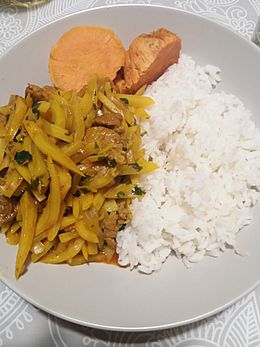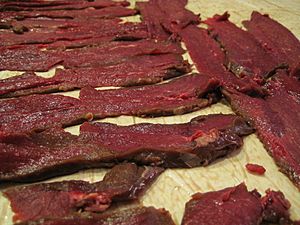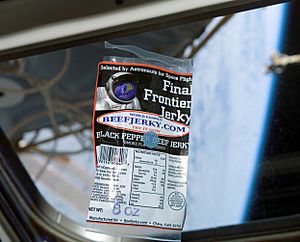Jerky facts for kids
Jerky is a super handy snack made from lean meat that's been cut into strips and dried out. Drying the meat helps stop it from going bad. Usually, salt is added too, which helps prevent tiny germs (bacteria) from growing before the meat is fully dry.
The word "jerky" comes from the Quechua word ch'arki, which means "dried, salted meat." All you really need to make basic jerky is a way to dry the meat at a low temperature and some salt.
Today, jerky you buy in stores is often soaked in a special liquid called a marinade, or it might have a mix of spices rubbed on it. Sometimes, it's even smoked with low heat. Many store-bought jerkies also have sweet things like brown sugar added.
Jerky is ready to eat right away and doesn't need any extra cooking. You can keep it for months without needing a fridge! This makes it a great snack for trips or emergencies. To make sure it lasts a long time, the jerky needs to have just the right amount of moisture compared to its protein content.
Some jerky products you see are made from meat that's been chopped up and reshaped, instead of traditional slices of whole meat. These might have a bit more fat, but they still need to meet certain moisture levels to be safe. Some jerky can also be very sweet because of all the sugar added.
Contents
How Jerky is Made
Jerky can be made from many different animals. This includes farm animals like beef, pork, goat, and lamb. Wild animals like deer, kangaroo, and bison are also used. You can even find jerky made from turkey, ostrich, salmon, alligator, and emu!
Before drying, most of the fat needs to be cut off the meat. This is because fat can make the jerky go bad faster. The meat also needs to dry quickly to stop bacteria from growing. To do this without cooking the meat, it's usually sliced very thin.
In big factories, jerky is dried in large ovens with lots of heaters and fans. These ovens blow air over the meat to remove moisture. The raw, seasoned meat strips are placed on special screens. The screens are then put on rolling carts that go into the drying oven. This process dries the meat in just a few hours.
Sometimes, special chemicals like sodium nitrite are used along with salt to help preserve the jerky. Smoking the meat is a very old way to make jerky. It helps preserve the meat, adds flavor, and dries it all at once. Salting is the most common method today. It adds flavor and helps keep the meat fresh. While some people use a marinade to add flavors, this can make the drying time longer because it adds moisture to the meat.
Packaging Jerky
Once the jerky is dry enough, it's cooled down and then put into plastic bags. These bags are often sealed with nitrogen gas or are vacuum-packed. This helps keep the jerky fresh. To stop the fat in the jerky from going bad, the sealed packages often have small packets inside called "oxygen absorbers." These packets contain tiny iron pieces that react with oxygen, removing it from the bag.
Because jerky has very little fat and moisture, it's packed with protein. For example, a small 30-gram (about 1 ounce) serving of jerky can have around 10 to 15 grams of protein. This is a lot for such a small amount!
In places like Hong Kong and Macau, you can find fresh, unpackaged jerky in specialty stores. Customers can choose from many different types of meat. This kind of jerky doesn't last as long as the sealed, packaged kind. In the USA, this is sometimes called "slab" jerky and is sold in clear containers in convenience stores.
Rules for Making Jerky
Most countries have rules about how dried meat products like jerky should be made. These rules help make sure that jerky is safe and healthy to eat. Factories that make jerky usually have inspectors and special plans to keep everything clean. In the United States, the USDA checks on jerky production. For example, poultry jerky (like turkey jerky) must be heated to a certain temperature to make sure it's safe.
Where to Find Jerky
Traditional jerky, made from whole slices of meat, is very popular in the United States, Mexico, and Canada. You can find it in almost every convenience store, gas station, and supermarket there. It has a long history as a food for pioneers. There's also a cheaper type of jerky made from finely ground meat that's shaped into strips. This is often labeled as "ground and formed" jerky.
You can also find shredded dry jerky, sometimes called meat floss, sold in containers. Jerky made the old-fashioned way is also common at farmers' markets in North America.
Jerky is also becoming popular in supermarkets and online stores in Australia, New Zealand, the United Kingdom, and Germany. In China, there's a similar product often made from pork called pork chip. In Rome, Italy, there's a snack called coppiette, which used to be made from horse or donkey meat but is now usually pork. It's seasoned with red pepper and fennel seeds.
In Tamil Nadu, India, a similar dish is called uppu kandam. In kerala (India), it's known as "idi irachi" and is usually deep-fried before eating. In Ethiopia, jerky is called qwant'a and is seasoned with black pepper and other spices. A similar product called biltong is popular in South African cuisine, but it's made differently. In Hausa cuisine, kilishi is a type of dried meat that's heavily spiced.
Jerky is often included in military field rations (food for soldiers). This is because it's light, very nutritious, lasts a long time, and can be eaten without any cooking. Since 1996, astronauts have even taken jerky into space as space food because it's light and full of nutrients!
Jerky's Nutrition
A typical 30-gram serving of jerky has about 10–15 grams of protein, only about 1 gram of fat, and very few carbohydrates (0–3 grams). Some beef jerky can have even more protein, over 65%!
Since traditional jerky uses a lot of salt to preserve it, the amount of sodium can be high. A 30-gram serving of jerky might have more than 600 milligrams of sodium. This is about 30% of the recommended daily amount for some people. Also, sugar can sometimes be the second ingredient listed after the meat itself.
Ch'arki: The Original Jerky

Ch'arki is the original dried, salted meat product from which the word "jerky" comes. It's a Quechua word meaning "dried, salted meat." In countries like Peru, Bolivia, and Chile, ch'arki is made from alpaca, llama, or mixes of the two. Peru makes a lot of ch'arki, about 450 tons each year! In Brazil, ch'arki is made from beef.
To make ch'arki, the meat is mostly salted and dried in the sun. In some areas, the meat is sliced before drying. In other places, whole pieces of meat with bones are dried.
When the Spanish arrived in South America, the Inca Empire used to provide llama ch'arki to travelers at special inns along their road system. The Inca people even used a special freeze drying process. They took advantage of the cold, dry mountain air and strong sun to preserve their meat.
See also
 In Spanish: Jerky para niños
In Spanish: Jerky para niños






